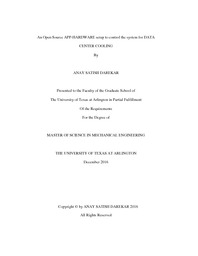
ATTENTION: The works hosted here are being migrated to a new repository that will consolidate resources, improve discoverability, and better show UTA's research impact on the global community. We will update authors as the migration progresses. Please see MavMatrix for more information.
Show simple item record
| dc.contributor.advisor | Agonafer, Dereje | |
| dc.contributor.advisor | Nomura, Seiichi | |
| dc.creator | Darekar, Anay Satish | |
| dc.date.accessioned | 2019-07-17T20:12:15Z | |
| dc.date.available | 2019-07-17T20:12:15Z | |
| dc.date.created | 2016-12 | |
| dc.date.issued | 2016-12-20 | |
| dc.date.submitted | December 2016 | |
| dc.identifier.uri | http://hdl.handle.net/10106/28382 | |
| dc.description.abstract | Control systems for data center cooling exists in the proprietary form and are often sold as part of the overall unit. They provide vital information related to the cooling systems and supply information on the temperature and humidity conditions inside the data center. Since most of these control systems software are proprietary they are expensive and hence not accessible to all. This project aims to develop a control system that operates on similar lines, but is economical and easily available. Developing a desktop or mobile based application not only gives the end user control over the cooling method (ex. DEC VS IEC) but also serves as a means to highlight ways in which one can reduce the usage of resources such as infrastructure, capital and energy
For optimal operation of the information technology (IT) module, the dry bulb temperature (T_DB) and relative humidity (∅) at the inlet of a server must either be in the ASHRAE recommended zone or should be as specified by the IT equipment manufacturer. The main aim of the aforementioned tool is to communicate with the cooling system and to ensure that the conditions (temperature and relative humidity) inside the data center facility remain in the desired operating zone irrespective of the conditions outside the data center. The software tool is developed to be implemented on a modular data center with air-side economization, direct and indirect evaporative cooling capabilities.
The hardware used for this is an Agilent 34972A DAQ unit, Arduino MEGA 2650, SHT 11 temperature and humidity sensor and J type thermocouple (Two), and for the software; NI LabView 2015 and Matlab R2016a. The hardware is chosen to prepare two types of configurations; both achieving the same goal of data acquisition, but at different operating costs. While developing such a software tool, there will be a few points that will be thoroughly emphasized upon such as the flexibility of being used on any Operating System and portability i.e. it can be set up on any device that supports a display and has an interactive screen
The tool aims to control the amount and the duration for which this cooling is provided. Also, optimizing the switching time between the scenarios that require cooling and that don’t can help us understand the efficiency with which the given cooling system can respond to inclement weather. This tool can help in deciding which cooling systems are best suited based on the location of the data center. | |
| dc.format.mimetype | application/pdf | |
| dc.language.iso | en_US | |
| dc.subject | Data center | |
| dc.subject | Data center cooling | |
| dc.subject | ASHRAE | |
| dc.subject | LabVIEW | |
| dc.subject | MATLAB | |
| dc.subject | Evaporative cooling | |
| dc.subject | Economical cooling | |
| dc.title | An Open Source APP-HARDWARE setup to control the system for DATA CENTER COOLING | |
| dc.type | Thesis | |
| dc.degree.department | Mechanical and Aerospace Engineering | |
| dc.degree.name | Master of Science in Mechanical Engineering | |
| dc.date.updated | 2019-07-17T20:12:15Z | |
| thesis.degree.department | Mechanical and Aerospace Engineering | |
| thesis.degree.grantor | The University of Texas at Arlington | |
| thesis.degree.level | Masters | |
| thesis.degree.name | Master of Science in Mechanical Engineering | |
| dc.type.material | text | |
Files in this item
- Name:
- DAREKAR-THESIS-2016.pdf
- Size:
- 346.5Mb
- Format:
- PDF
This item appears in the following Collection(s)
Show simple item record


